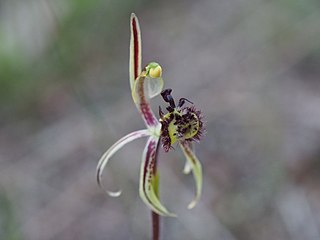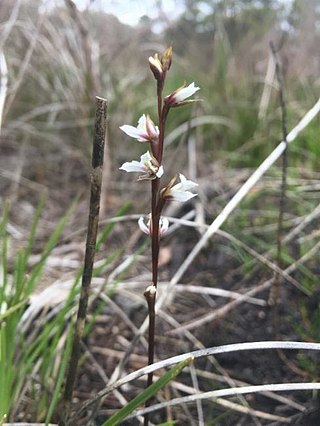
Caladenia saccharata, commonly known as sugar orchid, is a species of flowering plant in the orchid family, Orchidaceae and is endemic to the south-west of Western Australia. It has a single leaf and a single flower with three white sepals and two similar petals.

Caladenia barbarossa, commonly known as the common dragon orchid is a species of orchid endemic to the south-west of Western Australia. It can be distinguished by its distinctive labellum which is attractive to species of male thynnid wasps.
Caladenia abbreviata, commonly known as the coastal spider orchid, is a plant in the orchid family Orchidaceae and is endemic to the south-west of Western Australia. It has a single erect, hairy leaf and up to three pale, creamy-yellow flowers on a flowering stem up to 35 cm (10 in) high. Although the flowers have long, thread-like petals and sepals, they are shorter and darker than those of other spider orchids. It is a rare, relatively recently discovered species although often found near human activities.

Caladenia dundasiae, commonly known as the Patricia's spider orchid and Dundas spider orchid is a species of orchid endemic to a small area in the south-west of Western Australia. It is a rare orchid with a single hairy leaf and one or two, usually red flowers with thin, stiffly-held lateral sepals and petals.
Caladenia evanescens, commonly known as the semaphore spider orchid, is a species of orchid endemic to a small area near Albany in the south-west of Western Australia. It is a rare species with a single, hairy leaf and one or two cream-coloured to greenish-cream flowers.
Caladenia graminifolia, commonly known as the grass-leafed spider orchid is a species of orchid endemic to the south-west of Western Australia. It has a single glabrous leaf and one or two short-lived, greenish-yellow and red flowers which have a narrow labellum with long teeth on its sides.
Caladenia graniticola, commonly known as the Pingaring spider orchid, is a species of orchid endemic to the south-west of Western Australia. It has a single, hairy leaf and one or two yellowish-green, red and white flowers which have a greenish-yellow and white labellum with a red tip. It was originally described as Caladenia hoffmanii subsp. graniticola but has a slightly different labellum and column.

Caladenia granitora, commonly known as the granite spider orchid, is a species of orchid endemic to the south-west of Western Australia. It has a single, hairy leaf and one or two yellowish-cream, white and red flowers which have a white labellum with a red tip.
Caladenia harringtoniae, commonly known as the pink spider orchid, is a species of orchid endemic to the south-west of Western Australia. It has a single, hairy leaf and up to three pale to deep pink flowers which have a cream-coloured labellum with a pink tip.
Caladenia hoffmanii, commonly known as Hoffman's spider orchid is a species of orchid endemic to the south-west of Western Australia. It has a single, hairy leaf and one or two, greenish-yellow, red and white flowers which have a greenish-yellow labellum with a red tip. It is distinguished from the Pingaring spider orchid by small differences in the labellum and more northerly distribution.
Caladenia interjacens, commonly known as the Walpole spider orchid is a species of orchid endemic to the south-west of Western Australia. It has a single, hairy leaf and one or two pale pink and white flowers which lack the red tip on the labellum common to many other similar caladenias.
Caladenia lindleyana, commonly known as the Lindley's spider orchid is a species of orchid endemic to Tasmania. It has a single, hairy leaf and one or two greenish-yellow flowers tinged with red and with thin dark tips on the sepals. Very few plants of this species survive with only one plant, which has not been seen since 1997, protected in a reserve.

Caladenia multiclavia, commonly known as the lazy spider orchid is a species of orchid, endemic to the south-west of Western Australia. It has a single, hairy leaf and one or two greenish-yellow, red and cream-coloured flowers resembling a reclining spider. Although it usually only has a single flower, it often grows in clumps of up to six plants.

Caladenia swartsiorum, commonly known as the Island Point spider orchid, is a species of orchid endemic to the south-west of Western Australia. It has a single erect, hairy leaf and up to three pale greenish-yellow and white flowers and is only known from a small area near the Harvey Estuary.

Prasophyllum fimbria, commonly known as the fringed leek orchid, is a species of orchid endemic to the south-west of Western Australia. It is a tall orchid with a single smooth, tube-shaped leaf and up to seventy greenish-brown flowers with a white and pink labellum.

Prasophyllum brownii, commonly known as the Christmas leek orchid, is a species of orchid endemic to the south-west of Western Australia. It is one of the last of the genus in Western Australia to flower and has a tall flowering stem with up to eighty pale green and fawn-coloured flowers.
Prasophyllum cucullatum, commonly known as the hooded leek orchid, is a species of orchid endemic to the south-west of Western Australia. It is a tall orchid with a single smooth, tubular leaf and up to fifty or more purplish-red and white flowers with a frilled labellum crowded along a relatively short flowering stem.
Prasophyllum drummondii, commonly known as the swamp leek orchid, is a species of orchid endemic to the south-west of Western Australia. It is a late-flowering species with a single tubular leaf and up to thirty brownish-orange or pale yellow flowers and often grows in standing water.

Prasophyllum hians, commonly known as the yawning leek orchid, is a species of orchid endemic to the south-west of Western Australia. It is a common, tall leek orchid with a single smooth, tubular leaf and up to fifty or more pink and fawn flowers with a frilly labellum.
Microtis brownii, commonly known as the sweet mignonette orchid or sweet onion orchid, is a species of orchid endemic to the south-west of Western Australia. It has a single hollow, onion-like leaf and up to sixty small, green and white scented flowers well-spaced along the flowering stem. It usually grows in swampy places, flowers more prolifically after summer fires and sometimes forms very large colonies.










